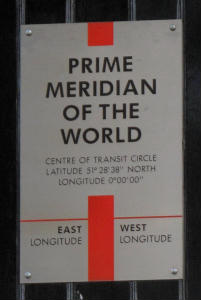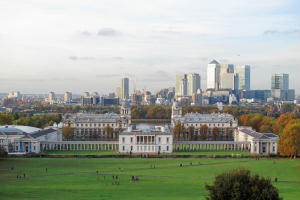Tourists Flock
to See Non-existent, Abstract Mathematical
Concepts
The Royal
Observatory at Greenwich, England, today
announced the opening to the public of two
further lines of longitude.
For many years,
the famous Zero or Prime Meridian at the
Observatory had attracted increasing numbers of
tourists, each wishing to be photographed whilst
standing upon it.
Queues often
stretched from the Observatory to the Thames, and
in 2009 visits to the Meridian had to be
restricted to those who purchased tickets in
advance.
 |
 |
 |
The Prime or Zero
Meridian
at the Royal Observatory
Greenwich, England
|
Tourists at the
Greenwich Royal Observatory
queuing to be photographed on
the Prime Meridian
|
The view
towards the Thames from
the Royal Observatory at Greenwich
Prior to 2009, the area would have been
packed with people queuing to be
photographed on the Prime Meridian |
With waiting
times for Prime Meridian tickets exceeding two
years, and many being sold for hundreds of pounds
on the black market, the Observatory decided that
it must act.
The new lines, representing
longitudes of 0° 0' 1" West and 0° 0' 1"
East, are about twenty yards either side of the
Prime Meridian. It is hoped that marking these as
alternative photo-opportunities will reduce
demand on 0° 0' 0".
A spokesperson for the
Royal Observatory confirmed that it might be
possible to similarly mark 0° 0' 2" West
and 0° 0' 2" East if the current plan
proved successful.
The desire by tourists to
be photographed in the vicinity of mathematically
useful, although non-existent, abstract concepts
has not been confined to Greenwich.
Passengers on Mediterranean
cruises had long objected to being deprived of
the special ceremonies and certificates enjoyed
by those aboard ships crossing the Equator, the
Tropic of Cancer, the Tropic of Capricorn and the
International Date Line. Their demands led to
additional imaginary lines being defined on the
surface of the earth, many of which have
attracted sponsorship from large organisations.
Cruises now cross the Tropic of Coca Cola, the
MacDonald’s Meridian and numerous other such
virtual locations, affording opportunities for
photography, partying and merchandising.
Concerns have been raised,
however, that the importance placed by many
people on some "non-existent, abstract
mathematical concepts", or NEAMCs, can have
a negative psychological impact.
A spokesperson for the
National Association of Psychologists highlighted
the trauma commonly experienced by individuals,
women in particular, as they approach an age
which is an exact multiple of ten - for example
thirty, forty, fifty or sixty. ‘The
increment of the first digit of their ages
coupled with the resetting of the second to zero
can have a devastating psychological effect,’
she observed. ‘The tragedy, of course, is
that these ages are entirely a by-product of the
decimal system, or counting to "base 10”,
as mathematicians describe it.’
Mathematicians tell us that
a numerical system can have any base. Perhaps the
best known, after decimal, is binary, as used by
computers. This counts to "base 2". The
binary number sequence thus runs 0, 1, 10, 11,
100, 101 and so on. The binary system, however,
has never been considered a good alternative for
expressing age as it rapidly reaches very large
numbers which can be even more distressing in the
period prior to birthdays.
An approach has fortunately
been developed by a Cambridge mathematician,
Professor Shirley Imnotthatold, aimed at limiting
such psychological trauma. Her system allows
anyone to choose his or her preferred age and
keep it the same, year after year, by
periodically changing the base used to count the
years.
For example, should someone
wish to remain in his or her twenties, thirty
years in “base 10” is the same as
twenty years in “base 15”, and forty
years in “base 10” is the same as
twenty years in “base 20”. If a person
has a preference for his or her thirties, fifty
years in “base 10” is the same as
thirty-five years in “base 15”.
In her paper for The
International Mathematical Journal,
Professor Imnotthatold notes that, '...when
revealing one’s age in normal conversation,
it should be possible to stress the desired
number while inaudibly mumbling details of the
base. Also, no “next birthday” need
ever end with “the big zero”.'
With the increasing
tendency in the modern world to place critical
importance on many things that simply do not
exist, it is hoped that the above initiatives and
mathematical techniques can allow people to
continue to enjoy placing irrational significance
on NEAMCs without inconvenience or harm.
|